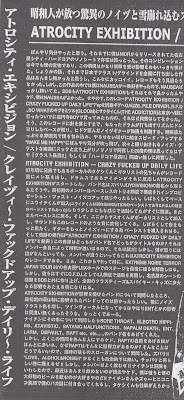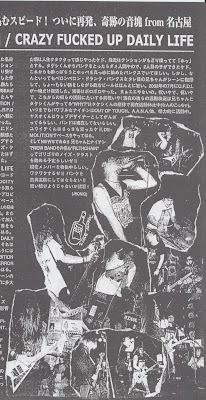Acid was a band from Tokyo, apparently active from the late 80's to the early 90's, judging from the recording dates going from 1987 to 1991. They were part of the same punk scene that gave birth to bands like DONDON, Asbestos or indeed Macrofarge, whose obsession with Doom we tackled earlier in the series and whose drummer would later on form Liberate with Acid's singer Kuro ("So they must have been mates," says Captain Obvious). As I mentioned in the introduction, I have never claimed to be some kind of expert in Japanese punk, and especially not in the mirific hardcore scene that is so revered. While preparing for this odyssey into waters still unchartered on Terminal Sound Nuisance, I listened to all kinds of Japanese punk music in order to connect the dots and try to find my way in a maze that, for all its alluringness, still felt like quite foreign. Like when you find yourself at a punk gig in a town you have never been to, but that you have heard of quite a lot, and you end up at that afterparty where you don't really know anyone and things are familiar but you aren't comfortable enough to really engage with the whole thing. A friend of mine with indisputable Japanese hardcore credentials mentioned Acid's "Gray Earth" Lp as having a solid crust edge despite the band's obvious roots in hardcore. Until then, I only knew "Shock troop", Acid's first album from 1989, that - and you can vilify me for this confession - I honestly was not that much of a sucker for, but then I had only listened to it distractedly maybe twice and I had real troubles getting over the fact that the band had had the nerve to call their album almost the same as Cock Sparrer's first Lp (a work I have been known to sing along to rather loudly on numerous occasions when pissed...). But I just punked up and gave "Gray Earth" a shot. And thank fuck I did, because not only is this album an absolute scorcher, but it is also a fascinating case in point of a specific punk phenomenon called "the crustification of hardcore".
I am pretty clueless what was up exactly with Tokyo punks in the late 80's, but something was definitely brewing. Applying the correlation between the rise of crust in Japan and the revival of the UK sound there to Acid is absorbing and complex, so it might be interesting to take a look at the band's discography while keeping this particular perspective in mind. Acid's first material appearance (according to Discogs, but for all I know there could have been earlier demos) was on the infamous, and awkwardly named, "Suck my dick" tape compilation released on Souzui Records (a label run by a DONDON bloke) in 1987, which incidentally was also the first SDS and Asbestos' release. It included two Acid songs which, in spite of a very rough sound (probably recorded live I reckon), illustrated rather aptly what the band was going for at the time: basically a high-energy union between Chaos UK and Japanese hardcore. The rather excellent 1988 demo confirmed that tendency but thanks to a better sound (still very raw but incredibly intense, it does not get much better than this sound-wise in terms of raw hardcore... just brilliant) brought additional dishes to the table, only this time you could actually read all the ingredients.
Of course, Acid was most definitely rooted in Japanese hardcore and a fair number of epic riffs and chorus arrangements screamed in that direction. However, most songs also nodded vigorously and interestingly toward Mower-era Chaos UK. After all, the Bristol punx had toured Japan in 1985 (which must have been quite an experience given the influence they have had on the Japanese scene in the 80's), and the studio side of the "Just mere slaves" 12'' (released on Selfish Records for the tour) must have been a huge influence on Acid. It was no longer the Riot City-era Chaos UK, by that time the band was faster, harder and more hardcore-oriented (I would almost argue proto-crust even, especially given the connections they had with the early UK crust bands). The priority was no longer given to the sloppy and the distorted (though it was still there of course) but to the intensity and aggression, a shift started with the "Short sharp shock" Lp from 1984. So Acid was a Bristol-influenced Japanese hardcore band focusing on post-84 Chaos UK and also the early Norwegian era of Disorder (the "noisecore" tag on the "Shock troop" insert acting as a fun reminder), as opposed to their glorious and noisy forefathers who had been traumatized by the pre-84 Bristol sound (for obvious chronological reasons). But Bristol was certainly not the sole point of reference in Acid's career up until the first Lp and other illustrious guests were invited: Crow of course, for the monomaniacal relentlessness and the aesthetics, Gauze, for the intensity of the delivery, but also early Antisect, as there are more than just a few riffs borrowed from them, possibly from the 1982 live tapes at that point in Acid's history. And, more importantly perhaps, I just cannot help hearing a heavy SoCal peacepunk vibe. It is in the vocals and some of the more dischargy moments, so much at times, that, had I not known that Acid were from Tokyo, I would have bet a tenner that some "Shock troop" songs were taken from an unreleased Apocalypse or Holocaust punky session. And that last element is actually crucial in my reading of Acid and especially of their later period (granted, I pretty much lived on Final Conflict and Crucifix in my late teens, so maybe I am just hearing things, or maybe the way we are educated to love punk music preconditions our later perception of it...).
Something happened to Acid in 1989. If "Shock troop" sounded like a logical progression from the 88' demo (the former being perhaps a little too polished and lacking in raw aggression for it to work completely for me), the five songs that Acid contributed to the "Get back the discharged arrow" compilation Lp, although released the same year as the first album, revealed a slight, but significant shift in terms of intent and sound. With a heavier, more metallic production and an emphasis on the drums, harsher vocals (even some gruff backing vocals) and a couple of obvious UK crust riffs, the songs hinted at the future Lp. The Chaos UK and Japanese hardcore tones were certainly not gone (the song "Free speech" was here to remind you of the God-like status of Bristol) but the presence of a very metallic number, "Democratic society?", can be seen as pointing in the direction of "Gray Earth". Perhaps no Acid song demonstrates this evolution as well as "Suck blood", a rather classic song that is present in every Acid recordings, from "Suck my dick" to "Gray Earth", and that emphasizes the changes in textures and mood that the band undertook throughout the years. Same song, different intent. A prime example of what is meant with the concept of "crust as tension and vibe".
"Gray Earth", despite having a couple of songs in common with earlier Acid works, is a different beast and the instrumental number introducing the Lp was there to make it very clear. It is a heavy, ominous, crustier than a squatter's socks, epic antisectish metal intro that just burst into an all-out fast crusty hardcore attack with gratuitous screams. The songs remain mostly fast and relentless but have a harsher edge (with the exception of the song "Free speech", again, being yet another reference to the band's roots in noisepunk), the riffs are heavier, thicker, darker and more insistent (not unlike Antisect's in fact), the vocals reminiscent of snotty metallic punk acts like Final Conflict and especially Apocalypse with some extra gruff crust vocals provided by the guitar player (who sounds a lot like Hiatus' first singer) and the bass is just thunderous, groovy and filthy. There is an undeniable protocrust vibe on "Gray Earth", like Crow teaming up with Final Conflict in Ipswich in 1986 or something, it is certainly not as all-over UK crust as Macrofarge since the backbone is still very much of the hardcore punk variety but the intent is undeniably here. Should I call it "Rags core", like the band proudly and noisily inferred? Yeah? Rags core it is then.
This Lp is almost mysterious when you think about it. Recorded in 1991, at a time when the early crust wave was actually folding, the songwriting reminds me of what preceded that wave by just a few yars. But then, there is the sound which turns what could almost be construed as a "five years too late" work into an incredibly modern album that must have been so influential for all the 90's Japanese crust bands. The production on "Gray Earth" is fantastic, very clear, almost unsettlingly so given the genre. You can hear that the band was at the top of its game and they knew exactly what they wanted in terms of textures, which was not the case of most of the bands having a go at that genre. I am reminded of SDS' bleak force at times but with the distinctive dark insistent power of Antisect as well (especially in the upfront sound of the drums) and the relentless flowing energy of ENT on the split with Filthkick and the deceptively chaotic mania of mid-80's Chaos UK, and yet it is also undeniably Japanese for all the intensity and the conviction. What an incredible album... The legacy of "Gray Earth" (and of Acid as a whole) escaped me for a long time but listening to this repeatedly showed that later crust bands like Gloom, Antiauthorize or Iconoclast borrowed more than a few songwriting and sound ideas from them (Gloom actually paid tribute to Acid by re-using the "Rags core" tag and turning it into "Rags speed noisecore", because, you know, Japanese punks just love to make up new cheesy subgenre names and so do I).
The cover of "Gray Earth" is pretty stark and definitely not as punky as their earlier works', if I did not know better, I would have thought they were a depressive cold-wave band from Switzerland or something. I really love the peace logo completed with two doves, as much referring to UK anarcho aesthetics than to antiwar Japanese hardcore punk. Really proper, especially with rather good, angry lyrics about Japan's warcrimes, greed, nuclear experiment or social conformity. Like "Shock troop" and "Get back the discharged arrow", "Gray Earth" was released on Selfish Record, a prominent Japanese hardcore label with a cult status due to its responsibility in putting out classics records from The Execute, Lip Cream, Death Side or SOB (among others) that, if you ever think of buying them all, would require you to contract a twenty-year loan.
Was Acid a Japanese hardcore band? Absolutely. Was "Gray Earth" a Japanese hardcore record? Maybe, but in a nasty crusty mood.

























